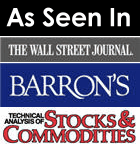I’m asked quite often the following question:
“When buying a stock, do you go with a ‘buy stop’ order or a ‘buy stop limit’ order?”
First, let me just quickly clarify the difference for those who may not already know. A buy stop order means that once price trades at or through the designated ‘stop’ price, a market buy order is generated. A buy stop limit order means that once price trades at or through the ‘stop’ price, a limit buy order is generated.
With that out of the way, here’s my answer and why.
When I’m setting up a buy order on a stock, I go with a buy stop. I’ll designate the ‘stop’ level at which I want price to trade at or through, which is pretty simple for me since I trade so many trend line breaks. The chart clearly shows me when price will have broken free, so I’ll set a buy stop usually a few cents beyond that price. This way, once price trades at or through the level I designate, a market buy order is generated.
Because probably 90% of the stocks I trade have at least 500k shares traded daily on average (many of them are well over 1M), there’s ample liquidity. I’m also sitting at my screens for most of the day, so I’m not worried about getting slipped on a stop order to enter a long position (or short). I have not been burned in quite a long time on a stop order to enter, which is just a function of the tighter markets we have these days. There is going to be some occasional slippage, which I simply view as a cost of doing business as a trader.
And on those occasions where it’s a gap situation (obviously a different situation from a wide bid/ask spread), if I get triggered into those well beyond my intended price (3% or more), I’ll just close them right out as the risk/reward of the play has just changed drastically to something more along the lines of 1:1. That will at times mean a gain or loss of a few cents, which over time really hasn’t hurt or helped me on a net basis. Again, I’m at my screens when that happens so it’s easy to ‘undo’ the trade with a quick exit.
Going with a buy stop order means I can catch every trade, which I really prefer even if it means being headfaked perhaps a bit more often. I’ve found that some of the very best trades clear a key level and never look back, which is a major issue with using a buy stop limit order. In a fast-moving market, that limit order may not ever get filled and you’ve tripped over pennies on the way to dollars.
For me, stop orders work well for entering new positions. For those who are concerned with slippage or who are not at their screens frequently, utilizing stop limit orders can protect against those situations.
Just understand that there is no perfect order type, so it’s important to consider your situation and go with the one that suits you best.
If you need to learn more about what all of this means, look into our Stock Trading Courses. In them, we cover executions and everything else related to active trading.
Trade Like a Bandit!
Jeff White
Take a trial to the Stock Pick Service to get my trades.










